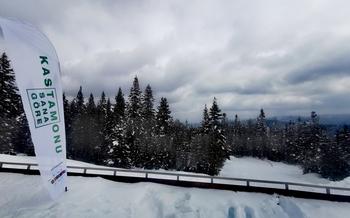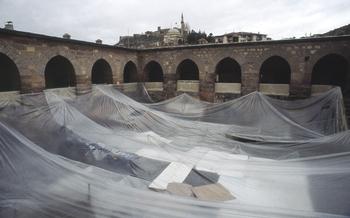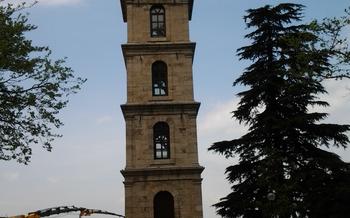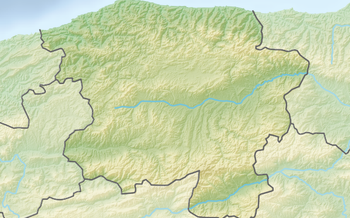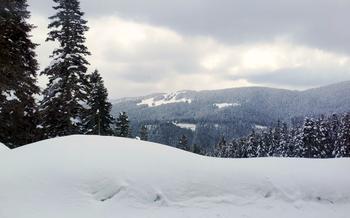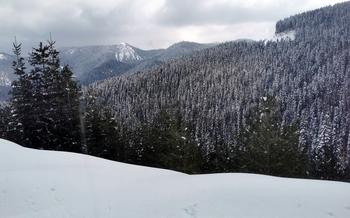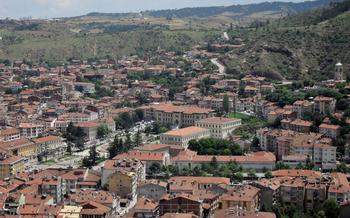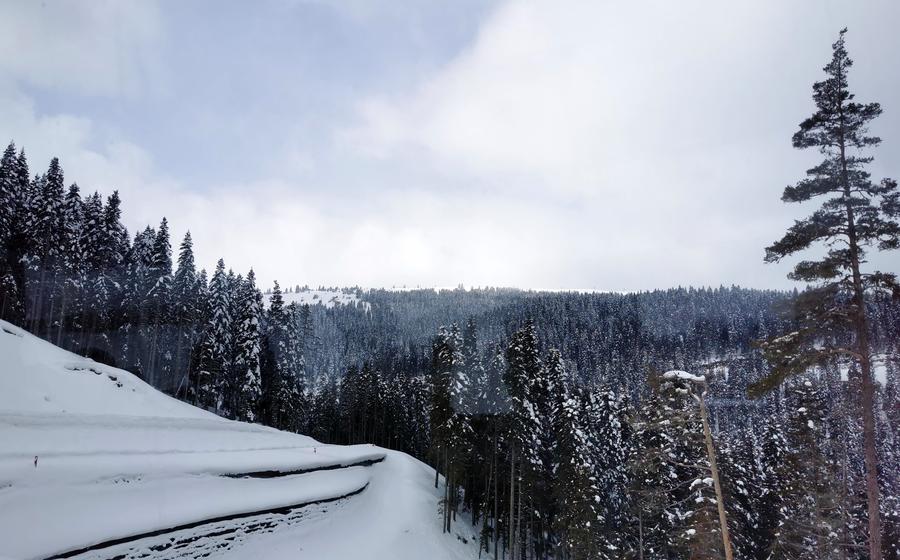
Tosya Castle
- Tosya Castle: A Monumental Fortress in Kastamonu
- Location and Accessibility
- History and Construction
- Architectural Design
- Defensive Features
- Panoramic Views
- Exhibitions and Displays
- Festivals and Celebrations
- Guided Tours
- Nearby Attractions
- Visiting Tips
- Photography Guidelines
- Souvenirs and Handicrafts
- Insider Tip: Hidden Gem
Tosya Castle: A Monumental Fortress in Kastamonu
Amidst the rich tapestry of Kastamonu's historical treasures, Tosya Castle stands as a testament to the region's enduring legacy. This monumental fortress, with its imposing presence and intricate architecture, has witnessed the passage of time and played a pivotal role in shaping the city's identity.
Historical significance: Erected in the 14th century, Tosya Castle served as a strategic stronghold for the Candarids, a powerful Anatolian beylik. It played a crucial role in defending the region against external threats, particularly during the tumultuous period of the Ottoman conquests. The castle's strategic location on the Silk Road, a vital trade route connecting East and West, further enhanced its importance.
Architectural features: Tosya Castle showcases a remarkable blend of architectural styles, reflecting the diverse influences that have shaped Kastamonu's history. Its imposing walls, fortified with sturdy towers and intricate gates, exude an aura of strength and resilience. The castle's interior reveals a labyrinth of chambers, courtyards, and hidden passages, each holding its own secrets and stories.
Defensive mechanisms: Tosya Castle's impressive fortifications are a testament to the ingenuity and military prowess of its builders. The castle's walls, constructed using a combination of stone and brick, stand tall and defiant, providing a formidable barrier against invaders. Drawbridges, portcullises, and secret escape routes further enhanced the castle's defensive capabilities, making it a formidable fortress.
Current state and preservation efforts: Today, Tosya Castle stands as a well-preserved relic of Kastamonu's rich past. Extensive restoration efforts have been undertaken to ensure its structural integrity and preserve its architectural splendor. Visitors to the castle can explore its many chambers, admire its intricate carvings, and immerse themselves in the history that permeates every stone.
Location and Accessibility
Tosya Castle stands tall in the heart of Tosya district, a charming town in the Kastamonu province of Turkey. To reach this awe-inspiring fortress, visitors can navigate to its exact address: Tosya Kalesi, Tosya, Kastamonu, Turkey. Immerse yourself in the historical aura of this ancient citadel by embarking on a journey through the picturesque landscapes of Kastamonu.
Transportation to Tosya Castle is a breeze, with various options available. For those seeking a scenic adventure, a leisurely train ride through the mesmerizing Turkish countryside is an excellent choice. Once in Tosya, local buses provide convenient connectivity to the castle, ensuring a seamless and affordable commute. If driving is more your style, the well-maintained roads leading to the castle offer a comfortable and direct route.
Distances from major cities to Tosya Castle vary, inviting travelers from near and far to explore its grandeur. From the vibrant capital, Ankara, the journey spans approximately 400 kilometers, promising a captivating road trip. The enchanting city of Istanbul lies at a distance of roughly 650 kilometers, beckoning history enthusiasts with its rich tapestry of cultures.
Parking facilities are readily available in the vicinity of Tosya Castle, catering to the convenience of visitors. Designated parking areas ensure a hassle-free experience, allowing you to embark on your historical exploration without any worries.
History and Construction
Tosya Castle's origins can be traced back to the 11th century, during the reign of the Seljuk Turks. It was initially built as a small fortress to protect the region from Byzantine attacks. Over the years, the castle underwent several expansions and renovations, particularly under the rule of the Ottomans in the 15th century. The Ottomans recognized the castle's strategic importance as a defensive stronghold and a symbol of their authority in the region. During this period, the castle was fortified with additional towers, walls, and gates, transforming it into an impregnable fortress.
One of the most significant events in the castle's history was the siege of Tosya in 1480 by the forces of Uzun Hasan, the ruler of the Aq Qoyunlu dynasty. Despite being outnumbered, the castle's defenders held their ground for several months, demonstrating the castle's resilience and defensive capabilities. The siege ended with the arrival of Ottoman reinforcements, who successfully repelled the invaders and preserved the castle's integrity.
Throughout its history, Tosya Castle played a crucial role in defending the region from external threats and maintaining stability and control. It served as a military garrison, an administrative center, and a refuge for the local population during times of conflict. Today, the castle stands as a testament to the rich history and architectural heritage of Kastamonu, attracting visitors from around the world who come to explore its fascinating past.
Architectural Design
Tosya Castle showcases an impressive architectural design that reflects the defensive and functional requirements of its time. The layout of the castle is elongated, with an east-west axis, measuring approximately 140 meters in length and 70 meters in width. The perimeter is defined by fortified walls, punctuated by towers and gates that served as entry points and defensive positions. The walls, built with sturdy stone blocks, stand tall and imposing, providing a formidable barrier against potential invaders.
The castle features multiple towers of varying sizes and shapes, primarily square or circular. These towers, strategically positioned along the walls, offered vantage points for surveillance and defense, allowing the garrison to keep watch over the surrounding landscape. Some towers also served specific purposes, such as the prison tower or the watchtower, which provided a panoramic view of the surrounding area.
The castle's interior reveals a network of chambers and spaces that served various functions. There are barracks for soldiers, storage rooms for supplies, stables for horses, and a cistern for water storage. The main gate of the castle, located on the eastern side, leads into a courtyard that served as a central gathering space and staging ground for military operations.
Among the unique architectural elements of Tosya Castle is the presence of arrow slits, narrow openings in the walls that allowed defenders to shoot arrows or other projectiles at attackers while minimizing their own exposure. These arrow slits, strategically placed throughout the castle, provided effective defensive capabilities.
Overall, the architectural design of Tosya Castle reflects a combination of defensive considerations and functional requirements, creating a fortress that was both resilient and practical, capable of withstanding attacks and supporting the needs of its garrison.
Defensive Features
Tosya Castle stands as a testament to medieval defensive ingenuity. Constructed atop a rocky hill, the castle's formidable walls, towering at an impressive height, exude an aura of strength and resilience. These ramparts, crafted from massive stone blocks, were designed to repel even the most determined attackers. Along the castle's perimeter, strategically positioned towers, each equipped with arrow slits and loopholes, provided a vantage point for archers and guards, allowing them to rain down a hail of projectiles upon any approaching enemy forces.
To further enhance the castle's defenses, a moat, once filled with water, encircles its base, creating a formidable obstacle for would-be invaders. Drawbridges, controlled from within the castle walls, spanned the moat, allowing controlled access while preventing unauthorized entry. Additionally, portcullises, heavy iron gates that could be lowered rapidly, provided an extra layer of protection at the castle's entrances.
Beyond these visible fortifications, Tosya Castle conceals a network of secret passages and escape routes, ensuring the safety of its inhabitants in times of siege. These hidden tunnels, often concealed behind inconspicuous doors or beneath the castle's foundations, provided a means of escape or a strategic advantage during battles. Within the castle's walls, an arsenal stocked with weapons and supplies stood ready, ensuring that the defenders were well-equipped to repel any attack.
Panoramic Views
Tosya Castle offers breathtaking vistas from its towering walls. As you ascend the ramparts, you'll be greeted with a panoramic tapestry of Kastamonu's enchanting landscapes. The city unfolds before you, with its red-tiled roofs, minarets piercing the sky, and the serpentine Gökırmak River meandering through the lush valley. Beyond the city limits, the panorama extends to rolling hills, verdant forests, and distant mountain ranges.
At sunset, the castle transforms into a magical realm as the sky erupts in a kaleidoscope of colors. The golden hues of the setting sun bathe the castle walls in a warm glow, casting long shadows across the surrounding landscape. As darkness descends, the city lights twinkle like a constellation of stars, creating a mesmerizing display.
Sunrise from the castle walls is equally captivating. As the first rays of sunlight peek over the horizon, the valley below awakens from its slumber. The mist that clings to the river gradually dissipates, revealing the intricate details of the surrounding countryside. The air is crisp and fresh, filling your lungs with a sense of tranquility and rejuvenation.
Whether you're a photography enthusiast capturing the castle's grandeur or simply a traveler seeking moments of serenity, Tosya Castle's panoramic views will leave you spellbound.
Exhibitions and Displays
Tosya Castle houses a fascinating museum that delves into the rich history and significance of this ancient fortress. Within its walls, visitors can embark on a journey through time, exploring captivating exhibits that showcase artifacts, documents, and historical accounts that bring the castle's past to life. Interactive displays and educational panels provide an engaging and immersive experience, allowing visitors to delve deeper into the castle's construction, defensive mechanisms, and its role in shaping the region's history. Temporary exhibitions and cultural events further enhance the museum's offerings, providing a dynamic and ever-changing showcase of the castle's heritage and significance.
Festivals and Celebrations
Tosya Castle, a majestic monument steeped in history, comes alive during local festivals, transforming into a vibrant hub of cultural expression. These festivals showcase the rich heritage of Kastamonu, immersing visitors in the region's traditions and folklore.
Traditional performances, music, and dance fill the air, captivating audiences with their energy and authenticity. Local artisans display their handcrafted goods at craft fairs, offering unique souvenirs and keepsakes inspired by the castle's history. Food stalls tempt visitors with delectable local specialties, allowing them to savor the flavors of Kastamonu.
Jousting tournaments and historical reenactments transport visitors back in time, providing a glimpse into the castle's glorious past. These events recreate the grandeur of medieval battles, showcasing the skills and valor of the region's warriors.
Attending a festival at Tosya Castle is an unforgettable experience that blends history, culture, and entertainment. Immerse yourself in the lively atmosphere, engage with the locals, and create lasting memories amidst the grandeur of this ancient fortress.
Guided Tours
Enhance your visit to Tosya Castle with a guided tour led by knowledgeable and experienced professionals. These tours are available in multiple languages, catering to international visitors. The guides possess a deep understanding of the castle's history, architecture, and significance, providing insightful commentary and anecdotes throughout the tour.
Thematic tours are also offered, allowing visitors to focus on specific aspects of the castle's history or architecture. These tours delve into the castle's defensive mechanisms, its role in major historical events, or the unique architectural elements that set it apart.
To ensure a spot on a guided tour, advance booking is recommended, especially during peak tourist season. Tour schedules vary depending on the time of year and the availability of guides. Check with the local tourism office or online platforms for tour schedules and booking information.
Nearby Attractions
Tosya Castle is just one of the many treasures that Kastamonu has to offer. Visitors to the city can explore various historical landmarks, natural wonders, and local experiences that showcase the region's rich heritage and diverse attractions.
-
Historical Sites: Discover the city's historical significance by visiting the Kastamonu Museum, which houses artifacts and exhibits from the region's past. The Kasaba Hamam, a restored 16th-century bathhouse, offers a glimpse into the city's Ottoman architecture.
-
Natural Wonders: Embark on a scenic adventure by visiting the Ilgar Mountain National Park, renowned for its breathtaking landscapes, hiking trails, and panoramic views. The Valla Kanyonu, a natural canyon with cascading waterfalls, offers a refreshing escape from the city's hustle and bustle.
-
Local Experiences: Immerse yourself in the local culture by exploring the vibrant markets and bazaars, where you can find traditional handicrafts, spices, and souvenirs. Indulge in the delectable flavors of Kastamonu's cuisine, savoring specialties such as "mantı," a type of Turkish ravioli, and "köfte," grilled meatballs.
-
Accommodation: Kastamonu offers a range of accommodation options to suit every budget and preference. From cozy guesthouses and boutique hotels to modern resorts, there are plenty of places to stay that will make your visit comfortable and memorable.
Visiting Tips
When planning your visit to Tosya Castle, there are a few tips to keep in mind for a more enjoyable and hassle-free experience:
-
Best Time to Visit: The ideal time to visit Tosya Castle is during the spring or fall months (April-May and September-October) when the weather is pleasant, and the crowds are smaller. Summer months can be hot and crowded, while winters can be cold and snowy, making it less suitable for outdoor exploration.
-
Dress Code: While there is no strict dress code for visiting the castle, it's advisable to dress respectfully, covering your shoulders and knees. Comfortable walking shoes are a must, as you'll be doing a lot of walking on uneven surfaces.
-
Accessibility: The castle is generally accessible to visitors with disabilities, with ramps and elevators available to reach different levels. However, some areas, such as the narrow staircases leading to the towers, may be challenging for wheelchair users.
-
Cultural Etiquette: As with any cultural site, it's important to be mindful of local customs and etiquette. Respect the privacy of other visitors, avoid touching or leaning on historical artifacts, and maintain a respectful tone when engaging with the locals.
Photography Guidelines
Tosya Castle is a photographer's paradise, offering endless opportunities to capture its grandeur and charm. While photography is generally permitted within the castle grounds, certain guidelines must be followed to ensure the preservation of the site and the privacy of other visitors.
Designated photography areas are marked throughout the castle, allowing visitors to take pictures without disturbing ongoing activities or damaging sensitive structures. The use of tripods is permitted in these designated areas, provided they do not obstruct walkways or hinder the movement of other visitors.
Flash photography is generally discouraged within the castle, as it can be disruptive to other visitors and potentially damage delicate artifacts. Natural light is often sufficient to capture the beauty of the castle, especially during the golden hours of sunrise and sunset.
Respecting the privacy of other visitors is paramount. Avoid taking pictures of individuals without their consent, especially when they are engaged in private conversations or activities.
To truly capture the essence of Tosya Castle, take your time to explore its nooks and crannies, experimenting with different angles and perspectives. The castle's rich history and architectural details provide endless subjects for creative photography.
Souvenirs and Handicrafts
Tosya Castle is a treasure trove of unique souvenirs and handicrafts that reflect the rich cultural heritage of Kastamonu. Within the castle walls, you'll find charming shops where local artisans showcase their exquisite creations, inspired by the castle's history and the surrounding landscapes.
From intricate pottery adorned with traditional motifs to handwoven textiles featuring vibrant colors, these souvenirs offer a tangible piece of Kastamonu to take home. You can find handmade jewelry, such as silver necklaces and earrings, that incorporate elements of the castle's architecture or local symbols.
For those who appreciate the written word, there are books and manuscripts that delve into the fascinating history of Tosya Castle and the region. These publications provide an enriching read for history buffs and curious travelers alike.
Remember that these local shops not only provide unique souvenirs but also support the livelihood of talented artisans who keep traditional crafts alive. By purchasing a handcrafted item, you contribute to preserving the cultural heritage of Kastamonu while taking home a cherished memento of your visit.
Insider Tip: Hidden Gem
Beyond the well-trodden paths of Tosya Castle, hidden gems await those who seek solitude, tranquility, and a deeper connection with its history. Venture off the main tourist routes and discover secret spots within the castle walls where you can soak in the serene atmosphere and appreciate the architectural intricacies without the throngs of visitors.
One such spot is the secluded garden nestled amidst the castle's ramparts. This hidden sanctuary offers a tranquil respite from the bustle of the castle grounds, inviting you to sit amidst the fragrant flowers, listen to the gentle rustling of leaves, and immerse yourself in the peaceful surroundings.
Another hidden gem is the lesser-known viewpoint atop the castle's highest tower. While the main viewing platforms draw the crowds, this overlooked spot offers breathtaking panoramas of the surrounding countryside, allowing you to capture the essence of the castle's strategic location and its commanding presence over the landscape.
To delve deeper into the castle's history, seek out the lesser-known tales and anecdotes that bring its past to life. Discover the stories of forgotten battles, heroic deeds, and intriguing characters that have shaped the castle's legacy. Local guides and historians can provide insights into these hidden narratives, enriching your understanding of Tosya Castle's significance.
Finally, to avoid the crowds and fully appreciate the castle's grandeur, plan your visit during the shoulder seasons or on weekdays. These quieter periods offer a more intimate and immersive experience, allowing you to connect with the castle's spirit without the distractions of large tour groups.

